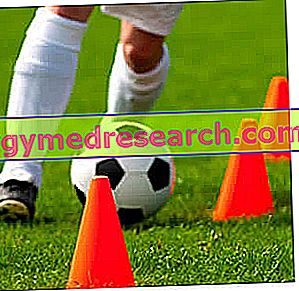By Dr. Nicola Sacchi - Author of the book: Drugs and doping in sport -
Many times in the gym there are players, amateurs and amateur athletes who want to train specifically to improve their skills for the sport.

Athletic training is also important to reduce the risk of injuries during the season, as a trained body allows you to better manage the efforts and possible traumas resulting from the sport. In particular, by strengthening the legs appropriately it is possible to reduce the incidence of knee injuries, which are the most classic of accidents, often causing forced stops for a long time that sometimes lead to the abandonment of sport; a good physical preparation therefore allows the athlete to also have a more serene and long-lived career.
There are many reasons to follow a good athletic preparation for a soccer player and there are many athletic components indispensable for this athlete, as football is a sport of mixed energy commitment, this involves the use of numerous physical components.
First of all, it is important to underline how a good generalized muscular tropism to the whole body is fundamental to sustain the contrasts with the adversaries. Every sport in which direct contact with opponents is present requires the athlete to have the maximum physical propensity to better manage these contrasts.
Football, as a situation sport, requires a high degree of responsiveness and coordination from the practitioner; only if you perfect these skills to the maximum can you respond quickly to the evolution of the situation on the field, which can change drastically and suddenly within fractions of seconds. For this reason the footballer's ability to respond reactively is decisive in the outcome of a match. Frontal, lateral and rotational movements, are movements necessary for the player, therefore they must be trained concretely to improve on the field, an adequate physical preparation must use exercises able to move the player in all directions, improving their responsiveness and coordination.
The need to interact directly with opponents, often coming into contact with them, implies the need to have a high degree of explosive strength and power, indispensable for responding to the opponent's action. We must also add that the explosive force is the basic physical capacity indispensable in every situation sport, since reactivity, power and speed also depend on it. Explosive force is necessary to perform direction changes, avoid adversaries and perform reactive movements easily. The explosive force is improved with ballistic exercises able to engage the body in the expression of strong contractions with extreme rapidity, thanks to the synergistic involvement of a large number of muscle groups. This athletic ability, if well trained, improves the body's ability to express rapid, sudden and reactive movements, allowing fast changes of direction and ensuring the ability to actively respond to the difficulties of the field.
Obviously a soccer player must also be fast and agile to overcome the opponents and reach the ball before the same. Training speed and agility is only possible with exercises based on taking shots in different situations, so special exercises that are too often rejected by the training cards proposed in traditional fitness centers.
Since football is a sport with mixed energetic commitment, it is necessary to include elements of cardiovascular work to train also the aerobic component of the performance.



